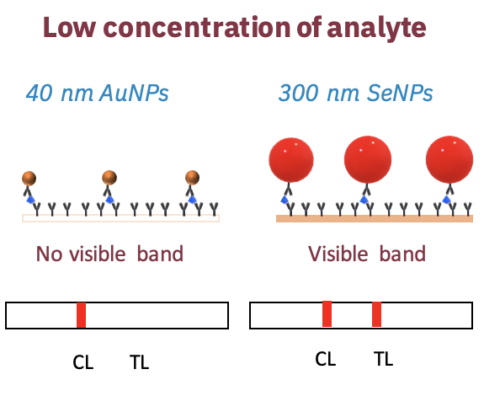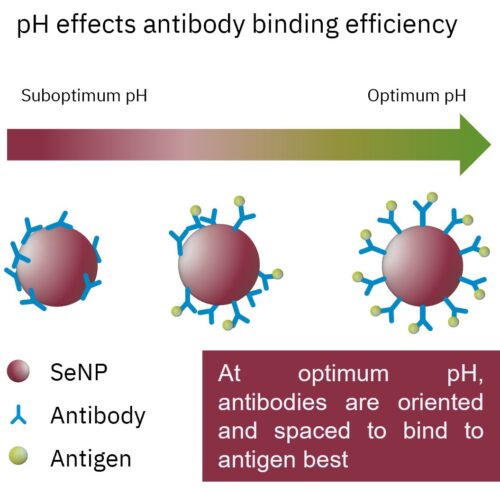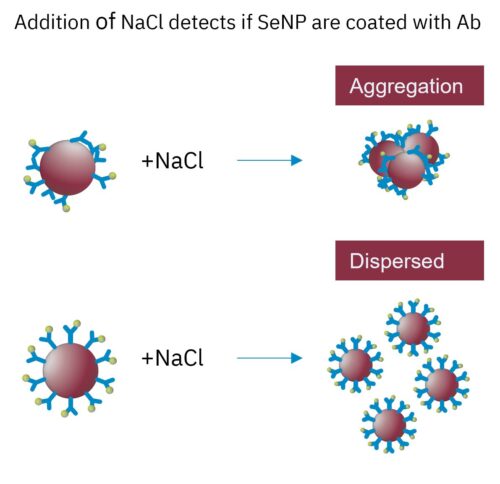In recent years Glantreo has developed and refined a process for the manufacture of selenium nanoparticles (SeNP). These particles are available in a range of sizes, including 250nm and 350nm, and are provided as a colloid. Glantreo SeNP are produced to be uniform in size with high monodispersity (CV < 6 %) and dependably spherical. From an end application perspective, this consistency in production ensures more even antibody binding, greater reliability for conjugation, and therefore better reproducibility for end assay application. The bright red colour of SeNP makes them ideal for use as labels for proteins in immunoassays such as lateral flow antigen tests. Additionally, SeNP are intrinsically fluorescent and well tolerated by healthy cells, making them ideal for in vitro fluorescence and invivo imaging.
In LFA and fluorescence imaging, SeNP need to be attached to proteins of interest. Proteins can be attached to SeNP by the simple process of passive adsorption.
The passive adsorption method is dependent on altering the pH of the protein to be attached to its isoelectric point (PI), where it can interact with the SeNP through hydrophobic interactions, van der waals and ionic interactions.
The SeNP passive adsorption kit provides 11 buffers between pH 5.3 and 9.3, for quick and easy adjustment of pH to match the PI of your protein of interest. Glantreo uses a robust method to produce dependably spherical and monodisperse SeNP. This consistency in nanoparticles translates to dependable antibody binding and greater reliability for conjugation, and therefore better reproducibility for your assay application.[/vc_column_text][vc_column_text]
Features and benefits
→ Glantreo SeNP are stable in a wide pH range between 5.3 and 9.3
→ Kit contains 11 buffers between pH 5.3 and 9.3 for quick and easy pH adjustment
→ SeNP are consistently monodisperse and spherical
→ SeNP are compatible with the NaCl aggregate test (10% W/V NaCl incl. in kit)
→ No sonication step required to resuspend conjugate
→ 10 times less antibody required to produce visible line on LFA when compared to gold and latex bead competitors at OD20 by an independent party
Summary Kit Contents
In addition to 5ml OD20 of either 250nm or 350nm SeNP, each kit includes 11 buffers in the 5.3 to 9.3pH range along with 10% W/V NaCl. See full list further down the page.
Further Details
Optimise binding of protein to SeNP
Using NaCl to test for successful attachment of protein to SeNP
Titration of protein concentration to determine minimum working concentration




The SeNP passive adsorption kit is used to optimise binding of proteins to SeNP
The goal of the SeNP passive adsorption kit is to streamline the process for determining A) the correct pH for the protein of interest, where coverage is tested by NaCl and B) the minimum concentration of protein to cover the SeNP.
Stable interactions between protein and SeNP are governed by pH
For passive adsorption to work, a buffer is used to adjust the pH to around isoelectric point (PI) of the protein. The nanoparticles in buffer can then be incubated with the protein and attach through a combination of hydrophobic interaction, van der waals forces and ionic interactions. Ideally the pH should be a little bit off the PI, to avoid compact conformation of antibody, caused by hydrophobic interactions between proteins. This allows the antibodies to be in better conformation to interact with antigen, while being sufficiently attached to the SeNP. If pH is too far above or below the PI, this can cause desorption of the protein and suboptimal coverage of the nanoparticle by the protein.

Once SeNP and protein are adjusted to the desired pH, protein coverage of the SeNP with protein can be determined by aggregation test with NaCl. If the pH is suboptimal, and coverage of the SeNP with protein is not sufficient, addition of NaCl will cause agglomeration of the particles and they will precipitate out of solution. If conditions are optimised, the surface of the SeNP is protected by the adsorbed protein, and the solution will remain its characteristic bright red.

Once the correct pH has been identified, the minimal protein concentration for complete coverage of SeNP can be determined. First the antibody is resuspended at the correct pH for binding. The antibody is then diluted to the desired concentration and added to the SeNP. After sufficient mixing and incubation, NaCl is added again. If antibody concentration is too low, the SeNP will agglomerate quickly, and precipitate out of the solution.
In addition to 5ml OD20 of either 250nm or 350nm SeNP, each kit includes 11 buffers in the 5.3 to 9.3pH range along with 10% W/V NaCl.
| Buffers & Reagents | pH | Volumes |
|---|---|---|
| MES Buffer | 5.3 | 1.5 mL |
| Sodium Phosphate Buffer | 5.7 | 1.5 mL |
| Sodium Phosphate Buffer | 6.1 | 1.5 mL |
| Sodium Phosphate Buffer | 6.5 | 1.5 mL |
| Sodium Phosphate Buffer | 6.9 | 1.5 mL |
| Sodium Phosphate Buffer | 7.3 | 1.5 mL |
| Borate Buffer | 7.7 | 1.5 mL |
| Borate Buffer | 8.1 | 1.5 mL |
| Borate Buffer | 8.5 | 1.5 mL |
| Borate Buffer | 8.8 | 1.5 mL |
| Borate Buffer | 9.3 | 1.5 mL |
| 10% W/V NaCl | 25 ml |


